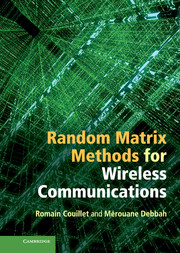Book contents
- Frontmatter
- Contents
- Preface
- Acknowledgments
- Acronyms
- Notation
- 1 Introduction
- Part I Theoretical aspects
- Part II Applications to wireless communications
- 11 Introduction to applications in telecommunications
- 12 System performance of CDMA technologies
- 13 Performance of multiple antenna systems
- 14 Rate performance in multiple access and broadcast channels
- 15 Performance of multi-cellular and relay networks
- 16 Detection
- 17 Estimation
- 18 System modeling
- 19 Perspectives
- 20 Conclusion
- References
- Index
13 - Performance of multiple antenna systems
from Part II - Applications to wireless communications
Published online by Cambridge University Press: 07 October 2011
- Frontmatter
- Contents
- Preface
- Acknowledgments
- Acronyms
- Notation
- 1 Introduction
- Part I Theoretical aspects
- Part II Applications to wireless communications
- 11 Introduction to applications in telecommunications
- 12 System performance of CDMA technologies
- 13 Performance of multiple antenna systems
- 14 Rate performance in multiple access and broadcast channels
- 15 Performance of multi-cellular and relay networks
- 16 Detection
- 17 Estimation
- 18 System modeling
- 19 Perspectives
- 20 Conclusion
- References
- Index
Summary
In this section, we study the second most investigated application of random matrix theory to wireless communications, namely multiple antenna systems, first introduced and motivated by the pioneering works of Telatar [Telatar, 1995] and Foschini [Foschini and Gans, 1998]. While large dimensional system analysis is easily defensible in CDMA networks, which typically allow for a large number of users with large orthogonal or random codes, it is not so for multiple antenna communications. Indeed, when it comes to applying approximated results provided by random matrix theory analysis, we expect that the typical system dimensions are of order ten to a thousand. However, for multiple input multiple output (MIMO) setups, the system dimensions can be of order 4, or even 2. Asymptotic results for such systems are then of minor interest. However, it will turn out in some specific scenarios that the difference between the ergodic capacity for multiple antenna systems and their respective deterministic equivalents is sometimes of order O(1/N), N being the typical system dimension. The per-receive antenna rate, which is of interest for studying the cost and gain of bringing additional antennas on finite size devices, can therefore be approximated within O(1/N2). This is a rather convenient rate, even for small N. In fact, as will be observed through simulations, the accuracy of the deterministic equivalents is often even better.
Quasi-static MIMO fading channels
We hereafter recall the foundations of multiple antenna communications.We first assume a simple point-to-point communication between a transmitter equipped with nt antennas and a receiver equipped with nr antennas.
- Type
- Chapter
- Information
- Random Matrix Methods for Wireless Communications , pp. 293 - 334Publisher: Cambridge University PressPrint publication year: 2011



